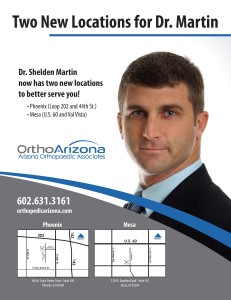Sports fans stay up-to-date on their favorite team or player while they rally around them toward a victory! The most disheartening news to hear while cheering on your team, is when a key player must sit out due to injury. During a game, NBA’s Brooklyn Nets’ star guard, Kyrie Irving, sustained a shoulder injury which is speculated to be a shoulder impingement or thoracic bursitis, and will keep him off the court for a little while.
Dr. Shelden Martin, team physician for the Arizona Cardinals, Diamondbacks and Rattlers, has experience with treating professional athletes. Dr. Martin offers his insight to the differences in the injuries along with treatment options:
“Shoulder impingement and scapulothoracic bursitis are slightly different problems, though both affect the shoulder girdle. Impingement or subacromial impingement, the most common type of impingement in the shoulder, though there are other types, is the most common. Most often seen in older patients, but when seen in young athletes is many times secondary to other problems, such as stiffness or motion problems from primary frozen shoulder or secondary stiffness after surgery. This can be problematic in overhead and throwing athletes playing sports such as baseball, volleyball, and gymnastics. It is often treated non-surgically with physical therapy, NDAIDs, and or cortisone injections. Less commonly it is treated with arthroscopic surgical decompression in young athletes.
Scapulothoracic bursitis is commonly seen in overhead athletes and results from poor scapular motion and mechanics or from repetitive use causing mechanical irritation of the bursa deep to and around the scapula. It is treated nonsurgically with NSAIDs, physical therapy and sometimes trigger point injections. This is a condition that is rarely ever treated surgically.”
Learn more about the Irving’s injury details here: https://nypost.com/2019/12/24/nets-kyrie-irving-could-still-be-weeks-away-from-injury-return/
Call 602.648.5444 to schedule an appointment with Dr. Shelden Martin today!














